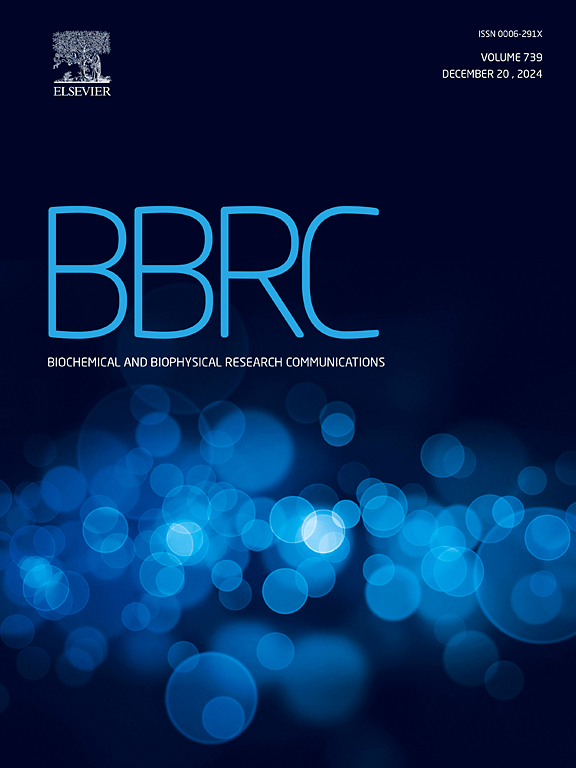Urolithin A attenuates pulmonary fibrosis via the PI3K/AKT/mTOR pathway: Evidence from network pharmacology and experimental validation
IF 2.2
3区 生物学
Q3 BIOCHEMISTRY & MOLECULAR BIOLOGY
Biochemical and biophysical research communications
Pub Date : 2025-06-17
DOI:10.1016/j.bbrc.2025.152219
引用次数: 0
Abstract
Objective
Pulmonary fibrosis(PF) is an abnormal wound-healing response resulting from recurrent alveolar injury, characterized by persistent inflammation and excessive collagen deposition. Given the limited clinical treatment options, novel therapeutic strategies are urgently needed. Urolithin A (UA), a secondary metabolite produced by intestinal microbiota from natural polyphenols, has attracted attention due to its anti-inflammatory, antioxidant, and anti-aging properties. However, the therapeutic efficacy and mechanisms of UA in PF remain unclear. This study aimed to investigate the protective effects and underlying molecular mechanisms of UA in PF.
Methods
This study integrated network pharmacology analysis, molecular docking, and in vitro/in vivo experiments to elucidate the anti-fibrotic mechanisms of UA. Firstly, a mouse model of PF was established via intratracheal instillation of bleomycin. Mice in the UA treatment group received daily oral administration of UA (20 mg/kg/day) starting on day 10 post-modeling and continuing until day 21, at which point lung tissues were collected. Histopathological alterations and collagen deposition in the lungs were assessed using Masson's trichrome staining and hydroxyproline content analysis. Furthermore, network pharmacology was employed to predict the potential molecular targets and pathways of UA, which were further validated through molecular docking and in vitro fibroblast experiments to verify the underlying mechanisms.
Results
UA treatment significantly alleviated PF in mice, evidenced by reduced collagen deposition, diminished structural damage, and notably decreased excessive extracellular matrix accumulation. Network pharmacology analysis and molecular docking indicated that the PI3K/AKT/mTOR signaling pathway is the primary pharmacological target of UA's anti-fibrotic effect. Further in vitro experiments demonstrated that UA significantly suppressed fibroblast activation by inhibiting AKT1 phosphorylation. Moreover, the inhibitory effects of UA on fibroblasts were reversed upon reactivation of the AKT pathway by the AKT agonist SC79, further confirming the crucial role of the AKT signaling pathway in UA's anti-fibrotic mechanism.
Conclusion
UA exerts therapeutic effects on PF by targeting the PI3K/AKT/mTOR pathway, particularly through the inhibition of AKT1 phosphorylation. These findings indicate that UA has potential as a therapeutic candidate for PF and provide a novel perspective for utilizing gut microbiota metabolites in the treatment of fibrotic diseases. Further studies are needed to elucidate the precise mechanisms of UA.
尿素A通过PI3K/AKT/mTOR通路减轻肺纤维化:网络药理学证据和实验验证
目的肺纤维化(PF)是由反复肺泡损伤引起的一种异常的创面愈合反应,其特征是持续的炎症和过多的胶原沉积。鉴于有限的临床治疗选择,迫切需要新的治疗策略。尿素A (urolitin A, UA)是肠道菌群从天然多酚类物质中产生的次生代谢产物,因其抗炎、抗氧化、抗衰老等特性而备受关注。然而,UA治疗PF的疗效和机制尚不清楚。方法采用网络药理学分析、分子对接和体外/体内实验相结合的方法,阐明UA的抗纤维化作用机制。首先,通过气管内滴注博来霉素建立PF小鼠模型。UA治疗组小鼠从造模后第10天开始,每天口服UA (20 mg/kg/天),持续至第21天,收集肺组织。使用马松三色染色和羟脯氨酸含量分析评估肺组织病理学改变和胶原沉积。此外,利用网络药理学预测UA的潜在分子靶点和通路,并通过分子对接和体外成纤维细胞实验进一步验证其潜在机制。结果a治疗可显著减轻小鼠PF,表现为胶原沉积减少,结构损伤减轻,细胞外基质过度积累明显减少。网络药理学分析和分子对接表明,PI3K/AKT/mTOR信号通路是UA抗纤维化作用的主要药理靶点。进一步的体外实验表明,UA通过抑制AKT1磷酸化显著抑制成纤维细胞的活化。此外,AKT激动剂SC79激活AKT通路后,UA对成纤维细胞的抑制作用被逆转,进一步证实了AKT信号通路在UA抗纤维化机制中的重要作用。结论ua通过靶向PI3K/AKT/mTOR通路,特别是通过抑制AKT1磷酸化对PF有治疗作用。这些发现表明,UA有潜力作为PF的治疗候选药物,并为利用肠道微生物代谢物治疗纤维化疾病提供了新的视角。需要进一步的研究来阐明UA的确切机制。
本文章由计算机程序翻译,如有差异,请以英文原文为准。
求助全文
约1分钟内获得全文
求助全文
来源期刊
CiteScore
6.10
自引率
0.00%
发文量
1400
审稿时长
14 days
期刊介绍:
Biochemical and Biophysical Research Communications is the premier international journal devoted to the very rapid dissemination of timely and significant experimental results in diverse fields of biological research. The development of the "Breakthroughs and Views" section brings the minireview format to the journal, and issues often contain collections of special interest manuscripts. BBRC is published weekly (52 issues/year).Research Areas now include: Biochemistry; biophysics; cell biology; developmental biology; immunology
; molecular biology; neurobiology; plant biology and proteomics

 求助内容:
求助内容: 应助结果提醒方式:
应助结果提醒方式:


